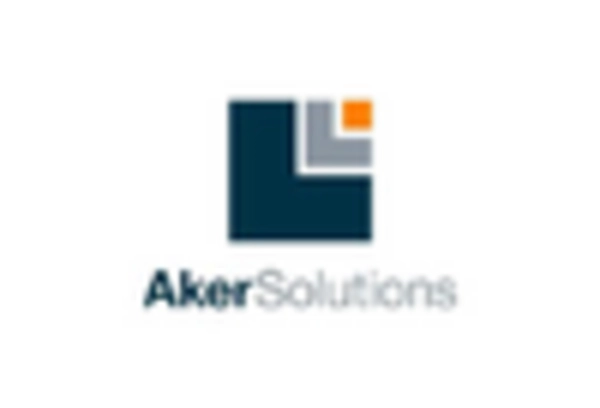Rising Demand for Energy Resources
The subsea well-access-systems market is experiencing a notable surge in demand for energy resources, particularly in the United States. As energy consumption continues to rise, the need for efficient extraction methods becomes paramount. This demand is driven by the increasing reliance on oil and gas, which are essential for various sectors, including transportation and manufacturing. The U.S. Energy Information Administration (EIA) projects that domestic oil production will reach approximately 12.4 million barrels per day by 2025. Consequently, subsea well-access-systems are critical for optimizing extraction processes, ensuring that operators can access deepwater reserves effectively. This trend indicates a robust growth trajectory for the subsea well-access-systems market, as companies seek to enhance their operational efficiency and meet the growing energy demands.
Investment in Infrastructure Development
Investment in infrastructure development is a critical driver for the subsea well-access-systems market. The U.S. government and private sector are allocating substantial resources to enhance offshore infrastructure, including pipelines and processing facilities. This investment is essential for supporting the growing demand for subsea resources and ensuring that extraction methods are efficient and reliable. According to recent reports, the U.S. offshore oil and gas infrastructure market is expected to reach $30 billion by 2026. As infrastructure improves, the subsea well-access-systems market is likely to benefit from increased operational capabilities and reduced downtime, ultimately leading to enhanced productivity and profitability for operators.
Technological Integration and Automation
The integration of advanced technologies and automation in the subsea well-access-systems market is transforming operational capabilities. Innovations such as remotely operated vehicles (ROVs) and autonomous underwater vehicles (AUVs) are enhancing the efficiency and safety of subsea operations. These technologies allow for real-time monitoring and data collection, which can lead to improved decision-making and reduced operational costs. According to industry estimates, the adoption of automation in subsea operations could reduce costs by up to 20% over the next few years. As companies in the U.S. strive to optimize their subsea operations, the demand for sophisticated well-access systems is likely to increase, driving growth in the market.
Regulatory Support for Offshore Exploration
Regulatory frameworks in the United States are increasingly supportive of offshore exploration, which significantly impacts the subsea well-access-systems market. The Bureau of Ocean Energy Management (BOEM) has been actively promoting responsible offshore drilling practices, thereby encouraging investments in subsea technologies. Recent policies aim to streamline the permitting process for new projects, which could lead to a resurgence in offshore drilling activities. This regulatory environment fosters innovation and investment in subsea well-access-systems, as companies look to comply with safety and environmental standards while maximizing resource extraction. The potential for new leases and exploration opportunities suggests a favorable outlook for the subsea well-access-systems market, as operators adapt to evolving regulations and seek advanced solutions.
Increased Focus on Environmental Sustainability
The subsea well-access-systems market is witnessing a growing emphasis on environmental sustainability, which is reshaping industry practices. Companies are increasingly adopting eco-friendly technologies and practices to minimize their environmental footprint. This shift is partly driven by public pressure and regulatory requirements aimed at reducing greenhouse gas emissions and protecting marine ecosystems. The U.S. government has set ambitious targets for reducing emissions, which could influence subsea operations. As a result, subsea well-access-systems that incorporate sustainable practices are becoming more attractive to operators. This trend suggests that the market will continue to evolve, with a focus on balancing resource extraction with environmental stewardship.

















Leave a Comment